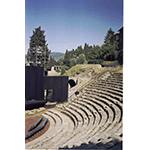Fiesole Archaeological Area
In antiquity Fiesole owed its fortune to its strategic position for controlling the roads linking central-southern Etruria to the Po Valley. The area, already urbanised in the archaic period, has undergone numerous changes over the course of time, the most important of them in the IV century B.C., when the centre was surrounded by an imposing circle of walls over 2,500 meters long.
Dating instead from the beginning of the Augustan Age (late I century B.C.), are the remodelling of the Etruscan temple, the construction of the Roman theatre and the public baths. Although partially rebuilt, the theatre constitutes one of the best-preserved examples in Tuscany. Semicircular in shape, it conserves, original, part of the cavea and of the vomitoria, the original entrances, of which big blocks of stone survive. At the top of the cavea remain traces of the covered gallery (crypta) giving access to the tiers of seats while, unfortunately, nothing has been conserved of the ancient three-doored stage front (scaena frons)
Regarding the public baths, still recognisable are the two outdoor swimming pools and the parts that were originally roofed over: the calidarium, with its system of suspensurae (little terracotta pillars of circular or square shape that served to support the floor, allowing hot air to circulate under it), the tepidarium and the frigidarium.
Within the archaeological zone today is the Archaeological Civic Museum which, in addition to displaying materials coming from the excavations and the collections of antiquarians, organises temporary exhibitions and workshops in Experimental Archaeology.
In the summer months, the Roman theatre finds again its ancient destination as a place for the performance of cultural and musical events, held in connection with the Estate Fiesolana (Summer in Fiesole).
****************************
Texts by Elena Fani
English translation by Catherine Frost
Last update 06/feb/2008




